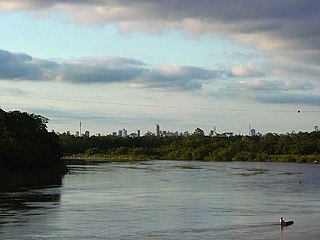
Mato Grosso do Sul is one of Brazil's 27 federal units, located in the southern part of the Central-West Region, bordering five Brazilian states: Mato Grosso, Goiás and Minas Gerais (northeast), São Paulo (east) and Paraná (southeast); and two South America countries: Paraguay and Bolivia (west). It is divided into 79 municipalities and covers an area of 357,145,532 square kilometers, which is about the same size as Germany. With a population of 2,839,188 inhabitants in 2021, Mato Grosso do Sul is the 21st most populous state in Brazil.

The Paraguay River is a major river in south-central South America, running through Brazil, Bolivia, Paraguay and Argentina. It flows about 2,695 kilometres (1,675 mi) from its headwaters in the Brazilian state of Mato Grosso to its confluence with the Paraná River north of Corrientes and Resistencia.

Cnidoscolus is a plant genus of the family Euphorbiaceae first described as a genus in 1827. The group is widespread across much of North and South America, including the West Indies.

Dalechampia is a genus of plant of the family Euphorbiaceae and of the monogeneric subtribe Dalechampiinae. It is widespread across lowland tropical areas primarily in the Americas with smaller numbers of species in Africa, Madagascar, and southern Asia. Additional new species are still being described and several are very rare and at risk of extinction.

The Mato Grosso campaign was an early Paraguayan offensive in the Paraguayan War. Paraguay invaded the Brazilian province of Mato Grosso.

Dyckia is a genus of plants in the family Bromeliaceae, subfamily Pitcairnioideae.

The Cuiabá River is a Brazilian river in the western state of Mato Grosso that flows in the Río de la Plata Basin. It is a tributary of the São Lourenço River.
Corumbá is an iron ore mine located in the western Brazilian state of Mato Grosso do Sul, near the border with Bolivia. The mine is located east of highway 262 about 15 km south of the city of Corumbá. The mine is of open pit construction, producing approximately 2 million tonnes per year of iron ore which is partially processed on site before being moved by barge along the Paraguay and Paraná Rivers to shipping ports along the Atlantic coast. The mine currently employs approximately 650 persons. The mine is currently owned by Vale S.A., who acquired it from multinational mining giant Rio Tinto Group in 2009 for US$814M.

The Apa River is a river of Paraguay and Brazil. It is a tributary of the Paraguay River, which in turn is a tributary of the Paraná River. It starts in the Amambai Mountains of the Brazilian state of Mato Grosso do Sul. The Apa forms part of the border between Paraguay and Brazil beginning at the twin cities of Bella Vista Norte and Bela Vista.
The Aporé River is a river forming the border between Goiás and Mato Grosso do Sul states in central Brazil. It is a tributary of the Paranaíba River, which enters the reservoir created by Ilha Solteira Dam on the Paraná River.
The Cabaçal River is a river of Mato Grosso state in western Brazil. It is a tributary of the Paraguay River.

The Jauru River is a river in Mato Grosso, a state in western Brazil. It is a tributary of the Paraguay River.

The Sepotuba River is a river in the state of Mato Grosso in western Brazil. It flows through the mountainous Serra do Tapirapuã region and is a tributary of the Paraguay River.

The Aquidauana River is a river of Mato Grosso do Sul state in southwestern Brazil. It is a tributary of the Miranda River, itself a part of the Paraguay River basin.

The Rio Negro is a river of Mato Grosso do Sul state in southwestern Brazil.
The Pardo River is a river of Mato Grosso do Sul state in southwestern Brazil. It is a tributary of the Paraná River, which it enters in the reservoir of Sérgio Motta Dam.

The Sucuriú River is a river of Mato Grosso do Sul state in southwestern Brazil. It is a tributary of the Paraná River, which it joins just upriver of Eng Souza Dias (Jupiá) Dam.

The Invasion of the then province of Mato Grosso by the forces of the Paraguayan Army in December 1864, the war declared, one of the first Brazilian reactions was to send a military land contingent to fight the invaders in Mato Grosso.














